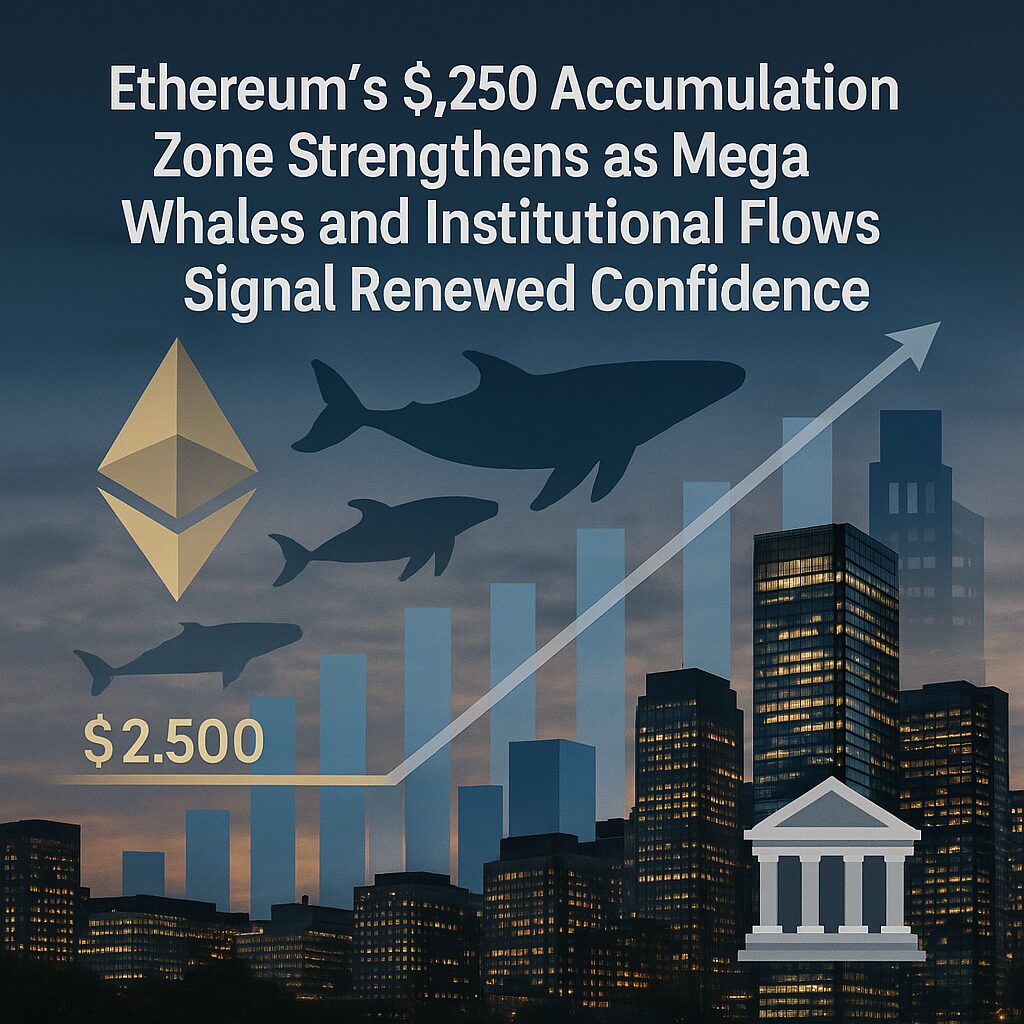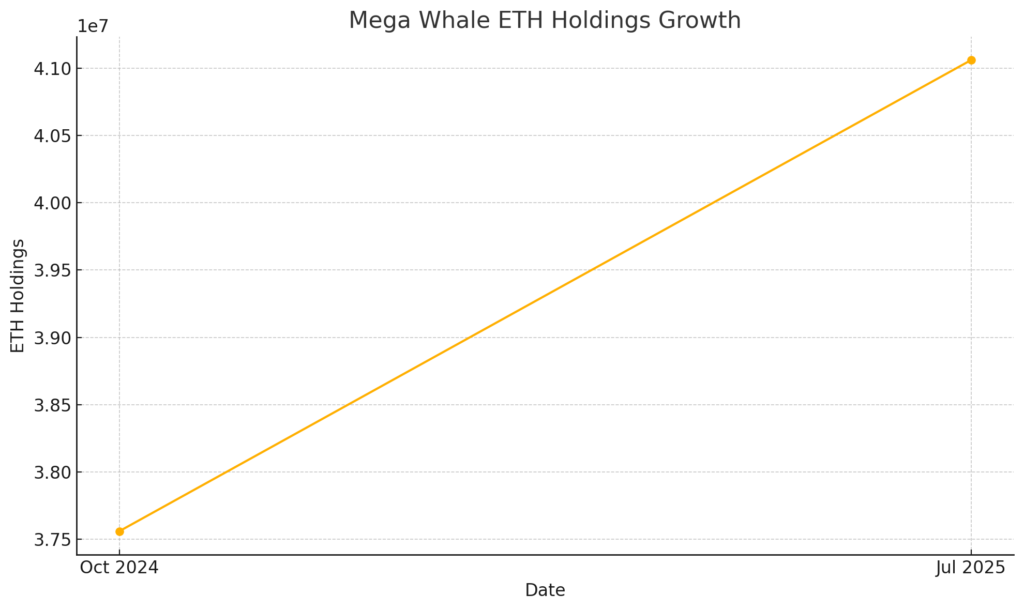
Main Points:
- Strong Accumulation at $2,500: On-chain data shows 3.45 million ETH accumulated between $2,513–2,536, marking the strongest zone in months, roughly double the pace of May–September 2022.
- Mega Whale Holdings Rebound: Mega whales now hold 41.06 million ETH, up 9% from the October 2024 low of 37.56 million ETH.
- Spot Ethereum ETF Inflows Surge: Weekly inflows into ETH products averaged 93,427 ETH ($216 million), contributing to a record $188 billion in crypto AuM for the week ending July 4, 2025.
- Institutional Stakebuilding: Nasdaq-listed SharpLink Gaming holds 205,634 ETH ($560 million), planning further purchases with $37.2 million in fresh funds.
- Ethereum Foundation Outflows: Despite whale and ETF demand, the Foundation withdrew ~1,000 ETH on July 6, the 21st outflow since April, totaling $53 million.
- Supply-Demand Dynamics Intensify: Combined whale accumulation, ETF inflows, and Foundation withdrawals underscore tightening supply, potentially fueling price support and upside momentum.
1. $2,500: A Powerful Accumulation Zone
On July 8, on-chain analytics platform Glassnode reported that the $2,500 area (specifically $2,513–2,536) has become the most intense accumulation zone in recent months, with 3.45 million ETH purchased at these levels. This contrasts sharply with the May–September 2022 period—when accumulation pace was half as strong—during which ETH rose from ~$880 to $2,000 in a rapid rally. The bar chart below visualizes this amplification of accumulation pressure.

The concentration of on-chain buy orders at $2,500 underscores a formidable support level, signaling that market participants—from retail accumulators to large entities—see this range as a value entry point ahead of a potential new uptrend.
2. Mega Whale Holdings: From Trough to Peak
Data from CryptoQuant shows that mega whales—addresses holding over 10,000 ETH—have increased their holdings from a record low of 37.56 million ETH on October 1, 2024, to 41.06 million ETH as of July 7, 2025, a 9% gain. This pace of accumulation is roughly double that seen during late 2022’s bear market and mirrors bullish pre-bull tendencies observed in late 2020, when whales grew their stash 4% before ETH exploded from $460 to $1,220.

The increase in whale holdings coincides with robust inflows into Ethereum-related ETFs, suggesting that both on-chain and off-chain demand drivers are converging to bolster ETH’s fundamentals.
3. Spot Ethereum ETF Inflows Reach New Heights
According to CoinShares’ July 7, 2025 report, digital asset products saw US$1.04 billion in weekly inflows, lifting total AuM to a record US$188 billion—the 12th consecutive week of positive flows. Ethereum products outperformed, averaging 1.6% of total AuM ($226 million) compared to Bitcoin’s 0.8% ($790 million) in the same period.
Further granularity from Lookonchain notes that U.S.-based spot ETH ETFs recorded a net inflow of 36,439 ETH ($92.2 million) on July 4 and $148.6 million on July 3, highlighting daily institutional appetite. With Bitwise CIO Matt Hougan forecasting up to $10 billion of ETH ETF inflows in H2 2025, growth in this channel appears poised to accelerate.
4. Institutional Stakebuilding: The SharpLink Gaming Case
On July 4, Nasdaq-listed SharpLink Gaming announced it holds 205,634 ETH—worth roughly ¥78.5 billion (US$560 million)—after buying 7,689 ETH at ~$2,501 per token between June 28 and July 4. The firm plans to deploy an additional $37.2 million raised in recent funding rounds to further ETH purchases.
SharpLink’s accumulation strategy exemplifies how institutional-grade entities leverage market dips to secure long-term positions, reinforcing the narrative that professional investors view Ethereum as a core infrastructure asset.
5. Ethereum Foundation Outflows: A Counterbalance
Conversely, CryptoQuant data indicates that the Ethereum Foundation withdrew 1,000 ETH ($2.5 million) on July 6, marking its 21st outflow since April and totaling ~$53 million in moved funds. While these withdrawals have historically funded development, grants, and ecosystem initiatives, they temporarily increase circulating supply, which could exert short-term selling pressure.
Balancing these outflows, however, are the more substantial demand metrics from whales and ETF inflows, suggesting overall supply-demand dynamics remain tilted bullishly.
6. Supply-Demand Dynamics and Price Implications
The synchronization of record accumulation at $2,500, whale hodling surges, and institutional ETF inflows points to an increasingly constrained supply base. Centralized exchanges now hold approximately 18 million ETH—a multi-year low—while growing amounts shift into cold storage or custodian wallets.
This reduced sell-side liquidity, coupled with anticipatory buying at key levels, sets the stage for robust price support. If historical patterns repeat—such as the 2022 mid-cycle rally or the late-2020 surge—ETH could see a breakout from the current $2,600–$2,800 consolidation toward fresh highs.
Conclusion
Ethereum’s $2,500 accumulation zone has emerged as a critical support, underpinned by 3.45 million ETH purchases, mega whale accumulation now at 41 million ETH, and persistent institutional ETF inflows. SharpLink Gaming’s hefty stakebuilding and continued demand from spot ETFs—averaging $200+ million per week—contrast with modest Ethereum Foundation outflows. As supply on exchanges plummets to multi-year lows, these converging signals herald a tightening market ahead of potential upside moves. For investors hunting new crypto assets and reliable yield sources, Ethereum’s current dynamics suggest both a strategic entry point and a reinforcing macro trend toward broader institutional adoption.

